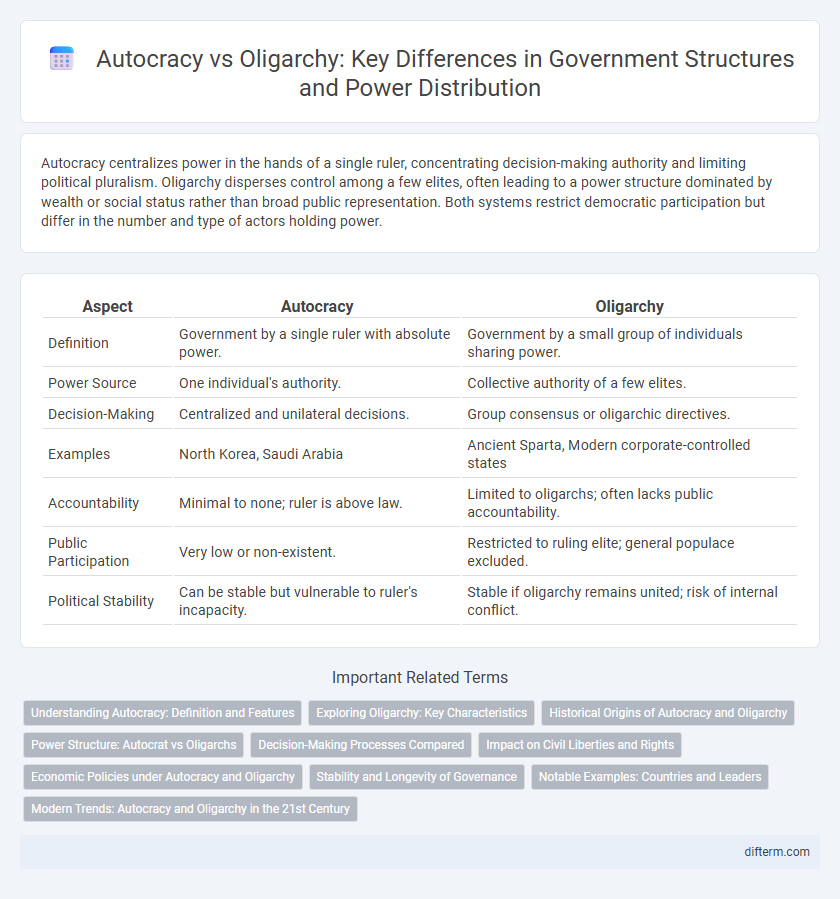Autocracy centralizes power in the hands of a single ruler, concentrating decision-making authority and limiting political pluralism. Oligarchy disperses control among a few elites, often leading to a power structure dominated by wealth or social status rather than broad public representation. Both systems restrict democratic participation but differ in the number and type of actors holding power.
Table of Comparison
| Aspect | Autocracy | Oligarchy |
|---|---|---|
| Definition | Government by a single ruler with absolute power. | Government by a small group of individuals sharing power. |
| Power Source | One individual's authority. | Collective authority of a few elites. |
| Decision-Making | Centralized and unilateral decisions. | Group consensus or oligarchic directives. |
| Examples | North Korea, Saudi Arabia | Ancient Sparta, Modern corporate-controlled states |
| Accountability | Minimal to none; ruler is above law. | Limited to oligarchs; often lacks public accountability. |
| Public Participation | Very low or non-existent. | Restricted to ruling elite; general populace excluded. |
| Political Stability | Can be stable but vulnerable to ruler's incapacity. | Stable if oligarchy remains united; risk of internal conflict. |
Understanding Autocracy: Definition and Features
Autocracy is a system of government where absolute power is concentrated in the hands of a single ruler, often a monarch or dictator, who wields unrestricted authority over the state without meaningful checks or balances. Key features of autocracy include centralized control, lack of political pluralism, and limited citizen participation in decision-making processes. This governance structure often suppresses dissent, restricts freedoms, and maintains power through coercion and hierarchical command.
Exploring Oligarchy: Key Characteristics
Oligarchy is a form of government where power is concentrated in the hands of a small, elite group often distinguished by wealth, family ties, or military control. This ruling class exercises control over political decisions, economic resources, and social influence, limiting broader public participation. Unlike autocracy, where a single ruler holds absolute power, oligarchies maintain power through collective dominance by a few individuals or families.
Historical Origins of Autocracy and Oligarchy
Autocracy originated in ancient civilizations where centralized power was vested in a single ruler, such as the pharaohs of Egypt and emperors of Rome, establishing absolute authority. Oligarchy emerged in city-states like ancient Sparta and Athens, where power was concentrated in the hands of a few elites or aristocrats controlling political decisions. These historical origins reflect contrasting governance structures rooted in the division of power and social hierarchy shaping early governmental systems.
Power Structure: Autocrat vs Oligarchs
Autocracy concentrates power in the hands of a single autocrat who holds absolute authority and decision-making control over the state. Oligarchy distributes power among a small group of oligarchs, where governance and influence are shared among elite members or families. The key distinction lies in centralized authority versus collective rule by a privileged few.
Decision-Making Processes Compared
In autocracies, decision-making is centralized, with a single ruler or authority wielding complete control over policies and governance, resulting in swift but often unchallenged decisions. Oligarchies concentrate power within a small group of elites or influential individuals who collectively influence laws and policies, allowing for more consultation within the group but limited participation from the broader population. Both systems limit democratic engagement, yet autocracies favor unilateral decrees, while oligarchies rely on negotiated consensus among a few powerful actors.
Impact on Civil Liberties and Rights
Autocracy centralizes power in a single ruler, often leading to severe restrictions on civil liberties and political rights due to unchecked authority and lack of accountability. Oligarchy concentrates control within a small group, which can result in selective limitations on freedoms, favoring elite interests while marginalizing broader public participation. Both governance forms typically suppress dissent and reduce transparency, undermining democratic principles and citizen protections.
Economic Policies under Autocracy and Oligarchy
Autocratic regimes often implement centralized economic policies with state-controlled industries and limited market competition, aiming for rapid development and political stability. Oligarchies tend to favor economic policies that benefit a small elite, resulting in wealth concentration and limited social mobility through regulatory capture and preferential access to resources. Both systems can hinder inclusive economic growth by prioritizing political control over broad-based market reforms.
Stability and Longevity of Governance
Autocracy often ensures stability through centralized authority and swift decision-making, minimizing dissent and political fragmentation. Oligarchy, while potentially more stable than democratic systems, can suffer from internal power struggles among elites that undermine long-term governance. Historical patterns indicate autocracies tend to maintain control longer if the ruling leader or faction retains legitimacy, whereas oligarchies face challenges sustaining cohesion over time.
Notable Examples: Countries and Leaders
Notable examples of autocracy include North Korea under Kim Jong-un, where centralized power is maintained through strict control and authoritarian rule. Oligarchies are exemplified by Russia, where political and economic power is concentrated among a small group of elites connected to President Vladimir Putin. Historical autocratic regimes include Adolf Hitler's Nazi Germany, while South Africa's apartheid era reflected oligarchic control by a minority white elite.
Modern Trends: Autocracy and Oligarchy in the 21st Century
Modern trends reveal a resurgence of autocracy with leaders consolidating power through digital surveillance and restricting civil liberties to maintain control. Simultaneously, oligarchic structures persist, where economic elites influence political decisions via lobbying and control over media. The interplay between these governance forms shapes global political stability and affects democratic institutions worldwide.
Autocracy vs Oligarchy Infographic

 difterm.com
difterm.com